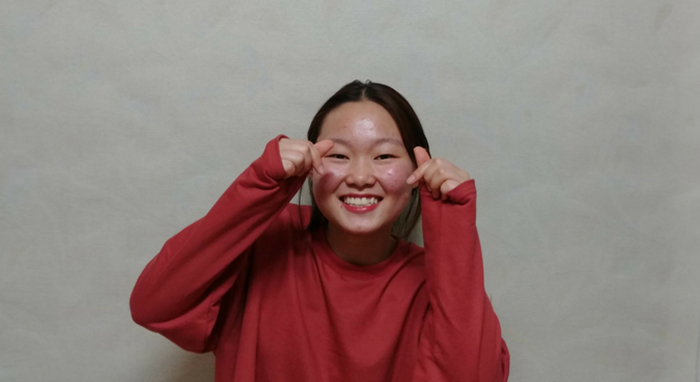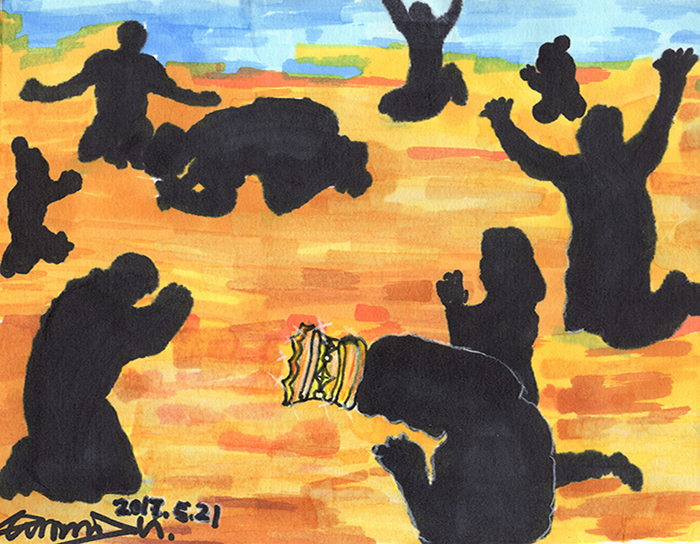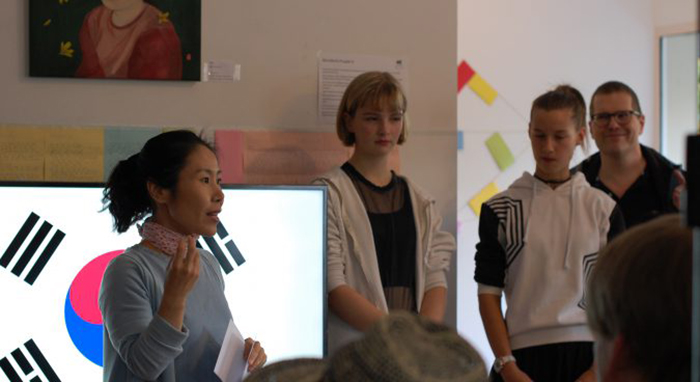
size="4" color="blue">What do the two Koreas mean to third-country born
children?
size="3" color="navy">More than 50% of defector schoolchildren are now of
third-country origin
lang="EN-US" style="mso-fareast-font-family:함초롬바탕;mso-font-width:100%;letter-spacing:0pt;mso-text-raise:0pt;">Damin
Jung September 28th, 2017
lang="EN-US" style="mso-fareast-font-family:함초롬바탕;mso-font-width:100%;letter-spacing:0pt;mso-text-raise:0pt;">When
South Koreans hear color="blue">“defectors,”
they usually think of Koreans that speak the same language, albeit with the
distinctive North Korean dialect. So when you visit a school for defector children
in the South, you might wonder why more than half now speak in Chinese.
lang="EN-US" style="mso-fareast-font-family:함초롬바탕;mso-font-width:100%;letter-spacing:0pt;mso-text-raise:0pt;"> color="navy">“My name is Chun-mi, and in Chinese pronunciation, it’s Chun
Mei ( color="navy">春美 color="navy">),” says
one student at the Durihana International School, an alternative school for
defector children in Seoul.
lang="EN-US" style="mso-fareast-font-family:함초롬바탕;mso-font-width:100%;letter-spacing:0pt;mso-text-raise:0pt;">Chun-mi
is the 17-year-old child of Su-jin Joo, who defected from North Korea 23 years
ago, and she was born in China.
lang="EN-US" style="mso-fareast-font-family:함초롬바탕;mso-font-width:100%;letter-spacing:0pt;mso-text-raise:0pt;">Out
of the roughly 30,000 North Korean refugees residing in South Korea, 71 percent
are women. For most of them, the process of defecting takes a long time: anything
from six months to eight years if things are delayed.
lang="EN-US" style="mso-fareast-font-family:함초롬바탕;mso-font-width:100%;letter-spacing:0pt;mso-text-raise:0pt;">Many
of them marry Chinese men after being sold by brokers. Chun-mi’s mother was
one of those who chose to cross the Tumen river. Though she was aware of human
trafficking in the border areas, she
believed life in China would be better than life in the North, where she languished
in poverty.
lang="EN-US" style="mso-fareast-font-family:함초롬바탕;mso-font-width:100%;letter-spacing:0pt;mso-text-raise:0pt;">Growing
up in the Chinese province of Henan before coming to South Korea two years ago,
Chun-mi never knew her mother was from North Korea.
lang="EN-US" style="mso-fareast-font-family:함초롬바탕;mso-font-width:100%;letter-spacing:0pt;mso-text-raise:0pt;"> color="navy">“Her accent was bit different, but I just thought it would be
that she came somewhere far in China,”
Chun-mi says. color="navy"> “I never knew there was a country called North Korea.”
lang="EN-US" style="mso-fareast-font-family:함초롬바탕;mso-font-width:100%;letter-spacing:0pt;mso-text-raise:0pt;"> color="navy">“I came to South Korea in 2015 but it was in 2016 ? the time
I started to speak Korean ? when I first found out there is North Korea.”
lang="EN-US" style="mso-fareast-font-family:함초롬바탕;mso-font-width:100%;letter-spacing:0pt;mso-text-raise:0pt;"> size="4" color="blue">Adjusting to life in South Korea can be even more
challenging than it is for those who directly came from the North
lang="EN-US" style="mso-fareast-font-family:함초롬바탕;mso-font-width:100%;letter-spacing:0pt;mso-text-raise:0pt;">Pastor
Chun Ki-won of the Durihana Mission, who has been helping defector families
including Chun-mi and her mother, says that many third-country-born children
grow up not knowing that one or both of
their parents are defectors.
lang="EN-US" style="mso-fareast-font-family:함초롬바탕;mso-font-width:100%;letter-spacing:0pt;mso-text-raise:0pt;"> color="navy">“They would not know unless their mothers tell them,” lang="EN-US" style="mso-fareast-font-family:함초롬바탕;mso-font-width:100%;letter-spacing:0pt;mso-text-raise:0pt;">Chun
tells NK News. color="navy">“However, most of the defector mothers hide where they are originally
from and how they were trafficked to forcibly get married, which is why their
children do not know they are defectors.”

style="font-family:함초롬바탕;mso-fareast-font-family:함초롬바탕;mso-font-width:100%;letter-spacing:0pt;mso-text-raise:0pt;"> color="purple">▲ color="purple">Chun-mi’s mother Soo-jin crossed Tumen River 23 years ago |
Photo: Wikimedia Commons
lang="EN-US" style="mso-fareast-font-family:함초롬바탕;mso-font-width:100%;letter-spacing:0pt;mso-text-raise:0pt;">The
number of third-country-born children in South Korea is increasing, with the
number of those currently enrolled in South Korean schools now outnumbering
young North Korean defectors, representing 1317 out of 2517 students enrolled
- 52.3% - at the end of December 2016, according to the MOU.
lang="EN-US" style="mso-fareast-font-family:함초롬바탕;mso-font-width:100%;letter-spacing:0pt;mso-text-raise:0pt;">With
the increase in the number of North Korean refugee families with children born
in third countries, the South Korean government has extended the one-time grant
of KRW4 million (USD$3482.04 at the time of publication) for defectors to those
born outside the peninsula.
lang="EN-US" style="mso-fareast-font-family:함초롬바탕;mso-font-width:100%;letter-spacing:0pt;mso-text-raise:0pt;">Though
the new policy is notable progress in the welfare provided to the growing number
of third-country born North Koreans in South Korea, it seems educational support
is more urgent, especially when it comes to language and culture.
lang="EN-US" style="mso-fareast-font-family:함초롬바탕;mso-font-width:100%;letter-spacing:0pt;mso-text-raise:0pt;"> size="4" color="blue">“I never knew there was a country called North Korea”
lang="EN-US" style="mso-fareast-font-family:함초롬바탕;mso-font-width:100%;letter-spacing:0pt;mso-text-raise:0pt;">For
children not born in the North or the South, adjusting to life in South Korea
can be even more challenging than it is for those who directly come from the
DPRK: they have to learn a completely different language and culture at the
same time.
lang="EN-US" style="mso-fareast-font-family:함초롬바탕;mso-font-width:100%;letter-spacing:0pt;mso-text-raise:0pt;"> color="navy">“I do not feel that I am from the same country when I see South
Korean people,”
Chun-mi says. color="navy">“In China, if I see people on the street, I just smile and talk
and it is so natural, but in South Korea, if I just look at people on the street,
they would think I am weird.”

color="purple">▲ color="purple">In a dream, Chun-mi saw Jesus praying for her in the middle
of a desert
lang="EN-US" style="mso-fareast-font-family:함초롬바탕;mso-font-width:100%;letter-spacing:0pt;mso-text-raise:0pt;">Since
many defector mothers have no choice but to spend most of their time working
for a living and away from their children, kids like Chun-mi often feel isolated
in a totally new country, Pastor Chun explains.
lang="EN-US" style="mso-fareast-font-family:함초롬바탕;mso-font-width:100%;letter-spacing:0pt;mso-text-raise:0pt;"> color="navy">“The children get more stress after coming to South Korea,” lang="EN-US" style="mso-fareast-font-family:함초롬바탕;mso-font-width:100%;letter-spacing:0pt;mso-text-raise:0pt;">
Pastor Chun says. color="navy"> “When they were in China they were able to talk and have friends
but after they came to South Korea in the hope that they now would live with
their moms who they were desperate to see, they find the reality is not like
that.”
lang="EN-US" style="mso-fareast-font-family:함초롬바탕;mso-font-width:100%;letter-spacing:0pt;mso-text-raise:0pt;">Like
many of the children of defector families, Chun-mi has often been left home
alone waiting for her mother, who has run a restaurant since last year.
lang="EN-US" style="mso-fareast-font-family:함초롬바탕;mso-font-width:100%;letter-spacing:0pt;mso-text-raise:0pt;">The
loneliness and pressure Chun-mi had been going through, she says, was not noticed
by teachers and friends, and not even by her mother, and led to her attempting
to take her own life by jumping from a balcony.
lang="EN-US" style="mso-fareast-font-family:함초롬바탕;mso-font-width:100%;letter-spacing:0pt;mso-text-raise:0pt;">The
incident saw Chun-mi diagnosed as paraplegic, with a doctor saying it was not
likely that she would walk again.
lang="EN-US" style="mso-fareast-font-family:함초롬바탕;mso-font-width:100%;letter-spacing:0pt;mso-text-raise:0pt;">Defying
expectations, however, she is walking again, and her life in South Korea had
dramatically changed. Receiving attention and care from her mother, friends,
and teachers made her feel loved and she has since become more outspoken.
lang="EN-US" style="mso-fareast-font-family:함초롬바탕;mso-font-width:100%;letter-spacing:0pt;mso-text-raise:0pt;"> size="4" color="blue">“The children get more stress after coming to South
Korea”
lang="EN-US" style="mso-fareast-font-family:함초롬바탕;mso-font-width:100%;letter-spacing:0pt;mso-text-raise:0pt;">The
media attention on her story saw her talent for painting be recognized by educators
and opened up new opportunities to study painting abroad, in Germany and the
U.S.
lang="EN-US" style="mso-fareast-font-family:함초롬바탕;mso-font-width:100%;letter-spacing:0pt;mso-text-raise:0pt;"> color="navy">“I just draw paintings when I feel lonely and have nothing to
do, and when I draw, I just don’t think of anything but draw things,” lang="EN-US" style="mso-fareast-font-family:함초롬바탕;mso-font-width:100%;letter-spacing:0pt;mso-text-raise:0pt;">
Chun-mi says.

style="font-family:함초롬바탕;mso-fareast-font-family:함초롬바탕;mso-font-width:100%;letter-spacing:0pt;mso-text-raise:0pt;"> color="purple">▲ color="purple">Chun-mi’s paintings were introduced at an exhibition in Berlin
| Photo: DAMSO Galerie & Teehaus
lang="EN-US" style="mso-fareast-font-family:함초롬바탕;mso-font-width:100%;letter-spacing:0pt;mso-text-raise:0pt;">After
Chun-mi’s story was broadcast on TV, her paintings were also introduced in
an exhibition in Zehlendorf (Berlin) on September 10, by DAMSO Galerie &
Teehaus, a private gallery in Berlin.
lang="EN-US" style="mso-fareast-font-family:함초롬바탕;mso-font-width:100%;letter-spacing:0pt;mso-text-raise:0pt;">Many
third-country-born children in South Korea, though they often do not know about
the division of the peninsula before coming to the South, see both Koreas as
home.
lang="EN-US" style="mso-fareast-font-family:함초롬바탕;mso-font-width:100%;letter-spacing:0pt;mso-text-raise:0pt;"> color="navy">“After I came to South Korea, I once went to the border area
with my mom,” she says. “It was New Year’s Day and my mom was looking at
North, towards her hometown there. I could feel her nostalgia.”
lang="EN-US" style="mso-fareast-font-family:함초롬바탕;mso-font-width:100%;letter-spacing:0pt;mso-text-raise:0pt;"> size="4" color="blue">“I just draw paintings when I feel lonely”
lang="EN-US" style="mso-fareast-font-family:함초롬바탕;mso-font-width:100%;letter-spacing:0pt;mso-text-raise:0pt;">Chun-mi
was awarded the grand prize at 18th color="navy">“Happy Peaceful Unification Writing and Painting Competition,”
for
her painting of the Mugunghwa (South Korea’s national flower), the Korean peninsula,
and tiger posing with victory hand gesture.
lang="EN-US" style="mso-fareast-font-family:함초롬바탕;mso-font-width:100%;letter-spacing:0pt;mso-text-raise:0pt;"> color="navy">“My mother is also a North Korean and my friends also came from
the North,” Chun-mi says. “I really want to see unification since I know how
my mother and friends feel color="navy">… color="navy">I wish the two Koreas could be united.”
lang="EN-US" style="mso-fareast-font-family:함초롬바탕;mso-font-width:100%;letter-spacing:0pt;mso-text-raise:0pt;">Edited
by: Oliver Hotham